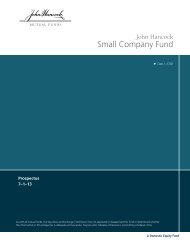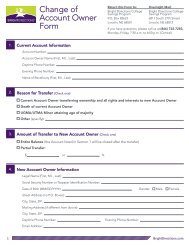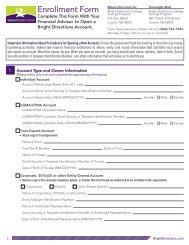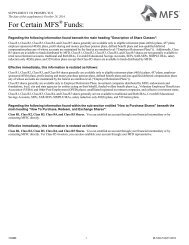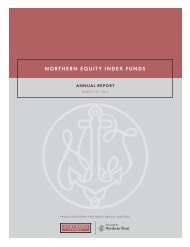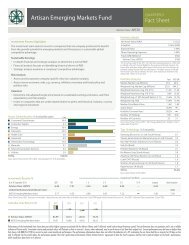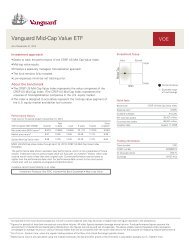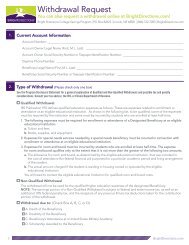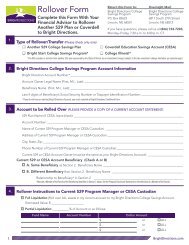Dodge & Cox Funds Statutoary Prospectus dated May 1, 2013
Dodge & Cox Funds Statutoary Prospectus dated May 1, 2013
Dodge & Cox Funds Statutoary Prospectus dated May 1, 2013
Create successful ePaper yourself
Turn your PDF publications into a flip-book with our unique Google optimized e-Paper software.
may be invested in below investment-grade debtsecurities, commonly referred to as high-yield or “junk”bonds, if they have a minimum rating of B by Moody’s,Fitch, or S&P, or are equivalently rated by any NRSRO.The Fund may also invest in interest rate derivatives suchas U.S. Treasury futures and swap agreements for a varietyof purposes, including, but not limited to, managing theFund’s duration or adjusting the Fund’s exposure to debtsecurities with different maturities. In addition, the Fundmay invest in credit default swaps to increase or decreasecredit exposure to a particular issuer or a group of issuersthat comprise a particular segment of the debt market.The proportions held in various debt securities maybe revised in light of <strong>Dodge</strong> & <strong>Cox</strong>’s appraisal of theeconomy, the relative yields of securities in the variousmarket sectors, the investment prospects for issuers, andother factors. In selecting debt securities, <strong>Dodge</strong> & <strong>Cox</strong>considers many factors, including yield-to-maturity,quality, liquidity, call risk, current yield, and capitalappreciation potential.While the mix of equity and debt securities will varydepending on <strong>Dodge</strong> & <strong>Cox</strong>’s outlook on the markets, undernormal circumstances no more than 75% (and no less than25%) of total assets will be invested in equity securities. TheFund may invest up to 20% of its total assets in U.S. dollardenominatedsecurities of non-U.S. issuers traded in theUnited States that are not in the S&P 500.PRINCIPAL RISKS OF INVESTINGYou could lose money by investing in the Fund, and theFund could underperform other investments. Youshould expect the Fund’s share price and total return tofluctuate within a wide range. The Fund’s performancecould be hurt by:▪ Issuer risk. Securities held by the Fund may decline invalue because of changes in the financial condition of,or other events affecting, the issuers of these securities.▪ Management risk. <strong>Dodge</strong> & <strong>Cox</strong>’s opinion about theintrinsic worth or creditworthiness of a company orsecurity may be incorrect, <strong>Dodge</strong> & <strong>Cox</strong> may not maketimely purchases or sales of securities for the Fund, theFund’s investment objectives may not be achieved, andthe market may continue to undervalue theFund’s securities.▪ Asset allocation risk. The Fund’s ability to achieve itsinvestment objective is affected by <strong>Dodge</strong> & <strong>Cox</strong>’sdetermination of the Fund’s broad asset allocationmix. <strong>Dodge</strong> & <strong>Cox</strong>’s evaluations and assumptionsregarding asset classes and market sectors may notsuccessfully achieve the Fund’s investment objective inview of actual market trends. The Fund’s balancebetween equity and debt securities could limit itspotential for capital appreciation relative to an all-stockfund or contribute to greater volatility relative to an allbondfund.▪ Equity risk. Equity securities generally have greater pricevolatility than debt securities.▪ Market risk. Stock prices may decline over short orextended periods due to general market conditions.▪ Non-U.S. issuer risk. Securities (including ADRs) maydecline in value because of political, economic, or marketinstability; the absence of accurate information about thecompanies; risks of internal and external conflicts; orunfavorable government actions, including expropriationand nationalization. These securities may also lose valuedue to changes in foreign currency exchange rates againstthe U.S. dollar and/or currencies of other countries. Non-U.S. securities are sometimes less liquid, more volatile,and harder to value than securities of U.S. issuers. Lack ofuniform accounting, auditing, and financial reportingstandards, with less governmental regulation andoversight than U.S. companies, may increase risk. Somecountries also may have different legal systems that maymake it difficult for the Fund to vote proxies, exerciseshareholder rights, and pursue legal remedies with respectto investments. These risks may be higher when investingin emerging markets companies. Certain of these risksmay also apply to securities of U.S. companies withsignificant non-U.S. operations.▪ Interest rate risk. Debt security prices may decline due torising interest rates. Debt securities with longermaturities are generally subject to potentially greaterprice volatility than obligations with shorter maturities.A low interest rate environment creates an elevatedrisk of future price declines, particularly for securitieswith longer maturities.▪ Credit risk. A security’s price may decline due todeterioration in the issuer’s or a guarantor’s financialD ODGE & C OX F UNDS ▪ PAGE 13




